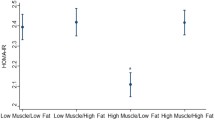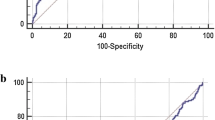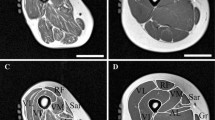Abstract
Background
Asians seem to have less skeletal muscle mass (SMM) than other ethnic groups, but it is not clear whether relative SMM, i.e., SMM / height square or SMM to fat-free mass (FFM) ratio, differs among different ethnic groups at the same level of body mass index (BMI).
Objective
To compare the SMM to fat-free mass (FFM) ratio as well as anthropometric variables and body composition among 3 ethnic groups.
Design, setting, and participants
Three hundred thirty-nine Japanese, 343 Brazilian, and 183 German men and women were recruited for this cross-sectional study.
Measurements
Muscle thickness (MTH) and subcutaneous fat thickness (FTH) were measured by ultrasound at nine sites on the anterior and posterior aspects of the body. FTH was used to estimate the body density, from which fat mass and fat-free mass (FFM) was calculated by using Brozek equation. Total SMM was estimated from ultrasound-derived prediction equations.
Results
Percentage body fat was similar among the ethnic groups in men, while Brazilians were higher than Japanese in women. In German men and women, absolute SMM and FFM were higher than in their Japanese and Brazilians counterparts. SMM index and SMM:FFM ratios were similar among the ethnic groups in women, excluding SMM:FFM ratio in Brazilian. In men, however, these relative values (SMM index and SMM:FFM ratio) were still higher in Germans. After adjusting for age and BMI, the SMM index and SMM:FFM ratios were lower in Brazilian men and women compared with the other two ethnic groups, while the SMM index and SMM:FFM ratios were similar in Japanese and German men and women, excluding SMM:FFM ratio in women.
Conclusion
Our results suggest that relative SMM is not lower in Asian populations compared with European populations after adjusted by age and BMI.
Similar content being viewed by others
References
Deurenberg P, Deurenberg-Yap M, Guricci S. Asians are different from Caucasians and from each other in their body mass index/body fat per cent relationship. Obes Rev. 2002;3(3):141–146.
Gurrici S, Hartriyanti Y, Hautvast JGAJ, Deurenberg P. Relationship between body fat and body mass index: differences between Indonesians and Dutch Caucasians. Eur J Clin Nutr. 1998;52(11):779–783.
Wang J, Thornton JC, Russell M, Burastero S, Heymsfield S, Pierson RN Jr. Asians have lower body mass index (BMI) but higher percent body fat than do whites: comparisons of anthropometric measurements. Am J Clin Nutr. 1994;60(1):23–28.
Rush EC, Freitas I, Plank LD. Body size, body composition and fat distribution: comparative analysis of European, Maori, Pacific Island and Asian Indian adults. Br J Nutr. 2009;102(4):632–641.
Abe T, Kearns CF, Fukunaga T. Sex differences in whole body skeletal muscle mass measured by magnetic resonance imaging and its distribution in young Japanese adults. Br J Sports Med. 2003;37(5):436–440.
Heymsfield SB, Gallagher D, Kotler DP, Wang Z, Allison DB, Heshka S. Body-size dependence of resting energy expenditure can be attributed to nonenergetic homogeneity of fat-free mass. Am J Physiol Endocrinol Metab. 2002;282(1):E132–E138.
Wang Z, Heo M, Lee RC, Kotler DP, Withers RT, Heymsfield SB. Muscularity in adult humans: proportion of adipose tissue-free body mass as skeletal muscle. Am J Hum Biol. 2001;13:612–619.
Abe T, Kondo M, Kawakami Y, Fukunaga T. Prediction equations for body composition of Japanese adults by B-mode ultrasound. Am J Hum Biol. 1994;6(2):161–170.
Brozek J, Grande F, Anderson JT, Keys A. Densitometric analysis of body composition: revision of some quantitative assumptions. Ann N Y Acad Sci. 1963;110:113–140.
Sanada K, Kearns CF, Midorikawa T, Abe T. Prediction and validation of total and regional skeletal muscle mass by ultrasound in Japanese adults. Eur J Appl Physiol. 2006;96(1):24–31.
Aleman-Mateo H, Lee SY, Javed F, Thornton J, Heymsfield SB, Pierson RN, Pi Sunyer FX, Wang ZM, Wang J, Gallagher D. Elderly Mexicans have less muscle and greater total and truncal fat compared to African-Americans and Caucasians with the same BMI. J Nurt Health Aging. 2009;13(10):919–923.
Author information
Authors and Affiliations
Rights and permissions
About this article
Cite this article
Abe, T., Bemben, M.G., Kondo, M. et al. Comparison of skeletal muscle mass to fat-free mass ratios among different ethnic groups. J Nutr Health Aging 16, 534–538 (2012). https://doi.org/10.1007/s12603-012-0015-2
Received:
Accepted:
Published:
Issue Date:
DOI: https://doi.org/10.1007/s12603-012-0015-2




